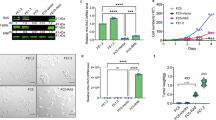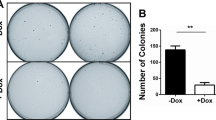Abstract
Activated forms of Ras family members are prevalent in many cancers where Ras mutants transduce signals essential for transformation, angiogenesis, invasion and metastasis. As a cancer progression model, we used NIH3T3 cells to explore the mechanism of Ras-induced tumorigenesis. Ras family mutants H-RasV12 and Rit79L strongly induced foci formation, while Rho family mutants RhoA-QL, Rac1-QL and Cdc42-QL were less effective. A comparison of downstream transcriptional targets of Ras and Rho family members using a 26 383 element cDNA microarray revealed that the osteopontin (OPN) gene exhibited the best correlation between magnitude of gene expression change and level of foci formation (r=0.96, P<0.001). In association with H-RasV12- and Rit79L-mediated transformation, foci secreted OPN protein and upregulated the OPN receptor CD44, suggesting the novel initiation of an aberrant OPN-CD44-Rac autocrine pathway. In support of this were the following observations. First, RGD-deficient OPN protein-binding activity was present in H-RasV12-transformed cells but not in control cells, and binding activity was inhibited by the CD44 blocking antibody. Second, foci formation, cell invasion and Rac activity were induced by H-RasV12 and inhibited by the CD44 blocking antibody. Third, foci formation by H-RasV12 was substantially reduced by a short interfering RNA (siRNA) specifically targeting OPN expression for knockdown. Fourth, H-RasV12-mediated transformation was not blocked by the GRGDS peptide, suggesting that OPN effects were not mediated by the integrins. Lastly, OPN knockdown affected the downstream expression of 160 ‘2nd tier’ genes, and at least a subset of these genes appears to be involved in transformation. Indeed, four genes were selected for knockdown, each resulting in a disruption of foci formation and/or invasion. These results underscore the role of aberrant autocrine signaling and transcriptional networking during tumorigenesis.
This is a preview of subscription content, access via your institution
Access options
Subscribe to this journal
Receive 50 print issues and online access
$259.00 per year
only $5.18 per issue
Buy this article
- Purchase on Springer Link
- Instant access to full article PDF
Prices may be subject to local taxes which are calculated during checkout








Similar content being viewed by others
References
Bachelder RE, Lipscomb EA, Lin X, Wendt MA, Chadborn NH, Eickholt BJ and Mercurio AM . (2003). Cancer Res., 63, 5230–5233.
Berken A, Abel J and Unfried K . (2003). Oncogene, 22, 8524–8528.
Bourguignon LY, Zhu H, Shao L and Chen YW . (2000). J. Biol. Chem., 275, 1829–1838.
Bourguignon LY, Zhu H, Zhou B, Diedrich F, Singleton PA and Hung MC . (2001). J. Biol. Chem., 276, 48679–48692.
Breen EC and Tang K . (2003). J. Cell. Biochem., 88, 848–854.
Bug G, Rossmanith T, Henshler R, Kunz-Schughart LA, Schroder B, Kampfmann M, Kreutz M, Hoelzer D and Ottmann OG . (2002). J. Leukoc. Biol., 72, 837–845.
Caplen NJ, Parrish S, Imani F, Fire A and Morgan RA . (2001). Proc. Natl. Acad. Sci. USA, 98, 9742–9747.
Choi SC, Kim KD, Kim JT, Kim JW, Yoon DY, Choe YK, Chang YS, Paik SG and Lim JS . (2003). FEBS Lett., 553, 413–418.
Conacci-Sorrell ME, Ben-Yedidia T, Shtutman M, Feinstein E, Einat P and Ben-Ze’ev A . (2002). Genes. Dev., 16, 2058–2072.
Connolly JO, Simpson N, Hewlett L and Hall A . (2002). Mol. Biol. Cell., 13, 2474–2485.
Coppola D, Szabo M, Boulware D, Muraca P, Alsarraj M, Chambers AF and Yeatman TJ . (2004). Clin. Cancer Res., 10, 184–190.
Crowe DL . (2004). Anticancer Res., 2B, 593–597.
Deng Y, Yao L, Chau L, Ng SS, Peng Y, Liu X, Au WS, Wang J, Li F, Ji S, Han H, Nie X, Li Q, Kung HF, Leung SY and Lin MC . (2003). Int. J. Cancer, 106, 342–347.
Denhardt DT, Mistretta D, Chambers AF, Krishna S, Porter JF, Raghuram S and Rittling SR . (2003). Clin. Exp. Metast., 20, 77–84.
Elbashir SM, Harborth J, Lendeckel W, Yalcin A, Weber K and Tuschl T . (2001). Nature, 411, 428–429.
Ellis CA and Clark G . (2000). Cell Signal, 12, 425–434.
Feng F and Rittling SR . (2000). Breat Cancer Res. Treat., 63, 71–79.
Furger KA, Menon RK, Tuck AB, Bramwell VH and Chambers AF . (2001). Curr. Mol. Med., 1, 621–632.
Hosack DA, Dennis Jr G, Sherman BT, Lane HC and Lempcki RA . (2003). Genome Biol., 4, R70.
Hu DD, Lin ECK, Kovach NL, Hoyer JR and Smith JW . (1995). J. Biol. Chem., 270, 26232–26238.
Katagiri YU, Murakami M, Mori K, Iizuka J, Hara T, Tanaka K, Jia W-J, Chambers AF and Uede T . (1996). J. Cell Biochem., 62, 123–131.
Katagiri YU, Sleeman J, Fujii H, Herrlich P, Hotta H, Tanaka K, Chikuma S, Yagita H, Okumura K, Murakami M, Saiki I, Chambers AF and Uede T . (1999). Cancer Res., 59, 219–226.
Mahabeleshwar GH, Das R and Kundu GC . (2004). J. Biol. Chem., 279, 9733–9742.
Malek RL, Irby RB, Guo QM, Lee K, Wong S, He M, Tsai J, Frank B, Liu ET, Quackenbush J, Jove R, Yeatman TJ and Lee NH . (2002). Oncogene, 21, 7256–7265.
Narumiya S . (1996). J. Biochem., 120, 215–228.
Novina CD and Sharp PA . (2004). Nature, 430, 161–164.
Oates AJ, Barraclough R and Rudland PS . (1996). Oncogene, 13, 97–104.
Oates AJ, Barraclough R and Rudland PS . (1997). Invas. Metast., 17, 1–15.
Ownby SE and Hohl RJ . (2002). Lipids, 37, 185–192.
Pavlidis P and Noble WS . (2001). Genome Biol., 2, research0042.1–0042.15.
Qu X, Wei H, Zhai Y, Que H, Chen Q, Tang F, Wu Y, Xing G, Zhu Y, Liu S, Fan M and He F . (2002). J. Biol. Chem., 277, 35574–35585.
Rozsnyay Z . (1999). Immunol Lett., 68, 101–108.
Rusyn EV, Reynolds ER, Shao H, Grana TM, Chan TO, Andres DA and Cox AD . (2000). Oncogene, 19, 4685–4694.
Sakbe K, Teramoto H, Zohar M, Behbahani B, Miyazaki H, Chikumi H and Gutkind JS . (2002). FEBS Lett., 511, 15–20.
Schlessinger J and Bar-Sagi D . (1994). Cold Spring Harb. Symp. Quant. Biol., 59, 173–179.
Screaton GR, Bell MV, Jackson DG, Cornelis FB, Gerth U and Bell JI . (1992). Proc. Natl. Acad. Sci. USA, 89, 12160–12164.
Sehgal A, Ricks S, Warrick J, Boynton AL and Murphy GP . (1999). Anticancer Res., 19, 4947–4953.
Servitja JM, Marinissen MJ, Sodhi A, Bustelo XR and Gutkind JS . (2003). J. Biol. Chem., 278, 34339–34346.
Sever N, Yang T, Brown MS, Goldstein JL and DeBose-Boyd RA . (2003). Mol. Cell, 11, 25–33.
Shiraishi Y, Mizutani A, Bito H, Fujisawa K, Narumiya S, Mikoshiba K and Furuichi T . (1999). J. Neurosci., 19, 8389–8400.
Singh RP, Kumar R and Kapur N . (2003). J. Environ. Pathol. Toxicol. Oncol., 22, 75–92.
Takai Y, Sasaki T and Matozaki T . (2001). Physiol. Rev., 81, 153–208.
Tanaka TS, Jaradat SA, Lim MK, Kargul GJ, Wang X, Grahovac MJ, Pantano S, Sano Y, Piao Y, Nagaraja R, Doi H, Wood III WH, Becker KG and Ko MS . (2000). Proc. Natl. Acad. Sci. USA., 97, 9127–9132.
Teramoto H, Malek RL, Behbahani B, Castellone MD, Lee NH and Gutkind JS . (2003). Oncogene, 22, 2689–2697.
Teriete P, Banerji S, Noble M, Blundell CD, Wright AJ, Pickford AR, Lowe E, Mahoney DJ, Tammi MI, Kahmann JD, Campbell ID, Day AJ and Jackson DG . (2004). Mol. Cell, 13, 483–496.
Troppmair J, Bruder JT, Munoz H, Lloyd PA, Kyrakis J, Banerjee P, Avruch J and Rapp UR . (1994). J. Biol. Chem., 269, 7030–7035.
Ue T, Yokozaki H, Kitadai Y, Yamamoto S, Yasui W, Ishikawa T and Tahara E . (1998). Int. J. Cancer, 79, 127–132.
Wang L, Schmitz V, Perez-Mediavilla A, Izal I, Prieto J and Qian C . (2003). Mol. Ther., 8, 72–79.
Weber GF, Ashkar S, Glimcher MJ and Cantor H . (1996). Science, 271, 509–512.
Wes PD, Yu M and Montell C . (1996). EMBO J., 15, 5839–5848.
Wu W, Wong K, Chen J, Jiang Z, Dupuis S, Wu JY and Rao Y . (1999). Nature, 400, 331–336.
Wu Y, Denhardt DT and Rittling SR . (2000). Br. J. Cancer, 82, 156–163.
Yue TL, McKenna PJ, Ohlstein EH, Farach-Carson MC, Butler WT, Johanson K, McDevitt P, Feuerstein GZ and Stadel JM . (1994). Exp. Cell Res., 214, 459–464.
Zhang J, Takahashi K, Takahashi F, Shimizu K, Ohshita F, Kameda Y, Maeda K, Nishio K and Fukuchi Y . (2001). Cancer Lett., 171, 215–222.
Zuber J, Tchernitsa OI, Hinzmann B, Schmitz AC, Grips M, Hellriegel M, Sers C, Rosenthal A and Schafer R. (2000). Nat. Genet., 24, 144–152.
Acknowledgements
We thank Dr Larry Fisher for the generous gift of the RGD-deficient OPN mutant.
Author information
Authors and Affiliations
Corresponding authors
Additional information
Supplementary Information accompanies the paper on Oncogene website (http://www.nature.com/onc).
Supplementary information
Rights and permissions
About this article
Cite this article
Teramoto, H., Castellone, M., Malek, R. et al. Autocrine activation of an osteopontin-CD44-Rac pathway enhances invasion and transformation by H-RasV12. Oncogene 24, 489–501 (2005). https://doi.org/10.1038/sj.onc.1208209
Received:
Revised:
Accepted:
Published:
Issue Date:
DOI: https://doi.org/10.1038/sj.onc.1208209
Keywords
This article is cited by
-
Blebs promote cell survival by assembling oncogenic signalling hubs
Nature (2023)
-
SPP1 promotes Schwann cell proliferation and survival through PKCα by binding with CD44 and αvβ3 after peripheral nerve injury
Cell & Bioscience (2020)
-
CD44v6 engages in colorectal cancer progression
Cell Death & Disease (2019)
-
The extracellular matrix in tumor progression and metastasis
Clinical & Experimental Metastasis (2019)
-
The role of osteopontin in the progression of solid organ tumour
Cell Death & Disease (2018)



